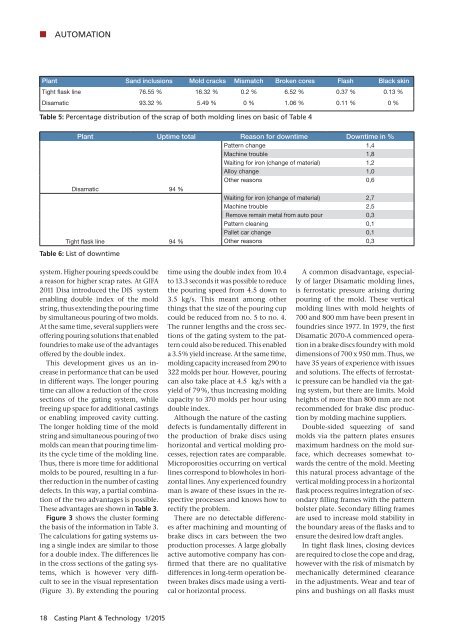CPT International 01/2015
The leading technical journal for the global foundry industry – Das führende Fachmagazin für die weltweite Gießerei-Industrie
The leading technical journal for the
global foundry industry – Das führende Fachmagazin für die
weltweite Gießerei-Industrie
You also want an ePaper? Increase the reach of your titles
YUMPU automatically turns print PDFs into web optimized ePapers that Google loves.
AUTOMATION<br />
Plant Sand inclusions Mold cracks Mismatch Broken cores Flash Black skin<br />
Tight flask line 76.55 % 16.32 % 0.2 % 6.52 % 0.37 % 0.13 %<br />
Disamatic 93.32 % 5.49 % 0 % 1.06 % 0.11 % 0 %<br />
Table 5: Percentage distribution of the scrap of both molding lines on basic of Table 4<br />
Plant Uptime total Reason for downtime Downtime in %<br />
Pattern change 1,4<br />
Machine trouble 1,8<br />
Waiting for iron (change of material) 1,2<br />
Alloy change 1,0<br />
Other reasons 0,6<br />
Disamatic 94 %<br />
Tight flask line 94 %<br />
Table 6: List of downtime<br />
Waiting for iron (change of material) 2,7<br />
Machine trouble 2,5<br />
Remove remain metal from auto pour 0,3<br />
Pattern cleaning 0,1<br />
Pallet car change 0,1<br />
Other reasons 0,3<br />
system. Higher pouring speeds could be<br />
a reason for higher scrap rates. At GIFA<br />
2<strong>01</strong>1 Disa introduced the DIS system<br />
enabling double index of the mold<br />
string, thus extending the pouring time<br />
by simultaneous pouring of two molds.<br />
At the same time, several suppliers were<br />
offering pouring solutions that enabled<br />
foundries to make use of the advantages<br />
offered by the double index.<br />
This development gives us an increase<br />
in performance that can be used<br />
in different ways. The longer pouring<br />
time can allow a reduction of the cross<br />
sections of the gating system, while<br />
freeing up space for additional castings<br />
or enabling improved cavity cutting.<br />
The longer holding time of the mold<br />
string and simultaneous pouring of two<br />
molds can mean that pouring time limits<br />
the cycle time of the molding line.<br />
Thus, there is more time for additional<br />
molds to be poured, resulting in a further<br />
reduction in the number of casting<br />
defects. In this way, a partial combination<br />
of the two advantages is possible.<br />
These advantages are shown in Table 3.<br />
Figure 3 shows the cluster forming<br />
the basis of the information in Table 3.<br />
The calculations for gating systems using<br />
a single index are similar to those<br />
for a double index. The differences lie<br />
in the cross sections of the gating systems,<br />
which is however very difficult<br />
to see in the visual representation<br />
( Figure 3). By extending the pouring<br />
time using the double index from 10.4<br />
to 13.3 seconds it was possible to reduce<br />
the pouring speed from 4.5 down to<br />
3.5 kg/s. This meant among other<br />
things that the size of the pouring cup<br />
could be reduced from no. 5 to no. 4.<br />
The runner lengths and the cross sections<br />
of the gating system to the pattern<br />
could also be reduced. This enabled<br />
a 3.5 % yield increase. At the same time,<br />
molding capacity increased from 290 to<br />
322 molds per hour. However, pouring<br />
can also take place at 4.5 kg/s with a<br />
yield of 79 %, thus increasing molding<br />
capacity to 370 molds per hour using<br />
double index.<br />
Although the nature of the casting<br />
defects is fundamentally different in<br />
the production of brake discs using<br />
horizontal and vertical molding processes,<br />
rejection rates are comparable.<br />
Microporosities occurring on vertical<br />
lines correspond to blowholes in horizontal<br />
lines. Any experienced foundry<br />
man is aware of these issues in the respective<br />
processes and knows how to<br />
rectify the problem.<br />
There are no detectable differences<br />
after machining and mounting of<br />
brake discs in cars between the two<br />
production processes. A large globally<br />
active automotive company has confirmed<br />
that there are no qualitative<br />
differences in long-term operation between<br />
brakes discs made using a vertical<br />
or horizontal process.<br />
A common disadvantage, especially<br />
of larger Disamatic molding lines,<br />
is ferrostatic pressure arising during<br />
pouring of the mold. These vertical<br />
molding lines with mold heights of<br />
700 and 800 mm have been present in<br />
foundries since 1977. In 1979, the first<br />
Disamatic 2070-A commenced operation<br />
in a brake discs foundry with mold<br />
dimensions of 700 x 950 mm. Thus, we<br />
have 35 years of experience with issues<br />
and solutions. The effects of ferrostatic<br />
pressure can be handled via the gating<br />
system, but there are limits. Mold<br />
heights of more than 800 mm are not<br />
recommended for brake disc production<br />
by molding machine suppliers.<br />
Double-sided squeezing of sand<br />
molds via the pattern plates ensures<br />
maximum hardness on the mold surface,<br />
which decreases somewhat towards<br />
the centre of the mold. Meeting<br />
this natural process advantage of the<br />
vertical molding process in a horizontal<br />
flask process requires integration of secondary<br />
filling frames with the pattern<br />
bolster plate. Secondary filling frames<br />
are used to increase mold stability in<br />
the boundary areas of the flasks and to<br />
ensure the desired low draft angles.<br />
In tight flask lines, closing devices<br />
are required to close the cope and drag,<br />
however with the risk of mismatch by<br />
mechanically determined clearance<br />
in the adjustments. Wear and tear of<br />
pins and bushings on all flasks must<br />
18 Casting Plant & Technology 1/2<strong>01</strong>5


















